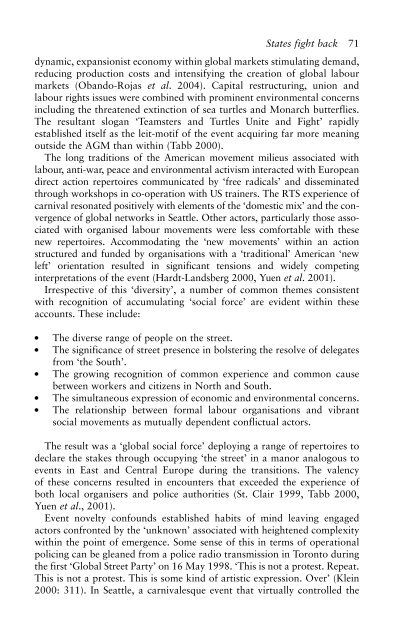Complexity and Social Movements: Multitudes at the Edge of Chaos ...
Complexity and Social Movements: Multitudes at the Edge of Chaos ...
Complexity and Social Movements: Multitudes at the Edge of Chaos ...
You also want an ePaper? Increase the reach of your titles
YUMPU automatically turns print PDFs into web optimized ePapers that Google loves.
St<strong>at</strong>es fight back 71<br />
dynamic, expansionist economy within global markets stimul<strong>at</strong>ing dem<strong>and</strong>,<br />
reducing production costs <strong>and</strong> intensifying <strong>the</strong> cre<strong>at</strong>ion <strong>of</strong> global labour<br />
markets (Ob<strong>and</strong>o-Rojas et al. 2004). Capital restructuring, union <strong>and</strong><br />
labour rights issues were combined with prominent environmental concerns<br />
including <strong>the</strong> thre<strong>at</strong>ened extinction <strong>of</strong> sea turtles <strong>and</strong> Monarch butterflies.<br />
The resultant slogan ‘Teamsters <strong>and</strong> Turtles Unite <strong>and</strong> Fight’ rapidly<br />
established itself as <strong>the</strong> leit-motif <strong>of</strong> <strong>the</strong> event acquiring far more meaning<br />
outside <strong>the</strong> AGM than within (Tabb 2000).<br />
The long traditions <strong>of</strong> <strong>the</strong> American movement milieus associ<strong>at</strong>ed with<br />
labour, anti-war, peace <strong>and</strong> environmental activism interacted with European<br />
direct action repertoires communic<strong>at</strong>ed by ‘free radicals’ <strong>and</strong> dissemin<strong>at</strong>ed<br />
through workshops in co-oper<strong>at</strong>ion with US trainers. The RTS experience <strong>of</strong><br />
carnival reson<strong>at</strong>ed positively with elements <strong>of</strong> <strong>the</strong> ‘domestic mix’ <strong>and</strong> <strong>the</strong> convergence<br />
<strong>of</strong> global networks in Se<strong>at</strong>tle. O<strong>the</strong>r actors, particularly those associ<strong>at</strong>ed<br />
with organised labour movements were less comfortable with <strong>the</strong>se<br />
new repertoires. Accommod<strong>at</strong>ing <strong>the</strong> ‘new movements’ within an action<br />
structured <strong>and</strong> funded by organis<strong>at</strong>ions with a ‘traditional’ American ‘new<br />
left’ orient<strong>at</strong>ion resulted in significant tensions <strong>and</strong> widely competing<br />
interpret<strong>at</strong>ions <strong>of</strong> <strong>the</strong> event (Hardt-L<strong>and</strong>sberg 2000, Yuen et al. 2001).<br />
Irrespective <strong>of</strong> this ‘diversity’, a number <strong>of</strong> common <strong>the</strong>mes consistent<br />
with recognition <strong>of</strong> accumul<strong>at</strong>ing ‘social force’ are evident within <strong>the</strong>se<br />
accounts. These include:<br />
● The diverse range <strong>of</strong> people on <strong>the</strong> street.<br />
● The significance <strong>of</strong> street presence in bolstering <strong>the</strong> resolve <strong>of</strong> deleg<strong>at</strong>es<br />
from ‘<strong>the</strong> South’.<br />
● The growing recognition <strong>of</strong> common experience <strong>and</strong> common cause<br />
between workers <strong>and</strong> citizens in North <strong>and</strong> South.<br />
● The simultaneous expression <strong>of</strong> economic <strong>and</strong> environmental concerns.<br />
● The rel<strong>at</strong>ionship between formal labour organis<strong>at</strong>ions <strong>and</strong> vibrant<br />
social movements as mutually dependent conflictual actors.<br />
The result was a ‘global social force’ deploying a range <strong>of</strong> repertoires to<br />
declare <strong>the</strong> stakes through occupying ‘<strong>the</strong> street’ in a manor analogous to<br />
events in East <strong>and</strong> Central Europe during <strong>the</strong> transitions. The valency<br />
<strong>of</strong> <strong>the</strong>se concerns resulted in encounters th<strong>at</strong> exceeded <strong>the</strong> experience <strong>of</strong><br />
both local organisers <strong>and</strong> police authorities (St. Clair 1999, Tabb 2000,<br />
Yuen et al., 2001).<br />
Event novelty confounds established habits <strong>of</strong> mind leaving engaged<br />
actors confronted by <strong>the</strong> ‘unknown’ associ<strong>at</strong>ed with heightened complexity<br />
within <strong>the</strong> point <strong>of</strong> emergence. Some sense <strong>of</strong> this in terms <strong>of</strong> oper<strong>at</strong>ional<br />
policing can be gleaned from a police radio transmission in Toronto during<br />
<strong>the</strong> first ‘Global Street Party’ on 16 May 1998. ‘This is not a protest. Repe<strong>at</strong>.<br />
This is not a protest. This is some kind <strong>of</strong> artistic expression. Over’ (Klein<br />
2000: 311). In Se<strong>at</strong>tle, a carnivalesque event th<strong>at</strong> virtually controlled <strong>the</strong>




